2017 NISSAN LEAF weight
[x] Cancel search: weightPage 9 of 424
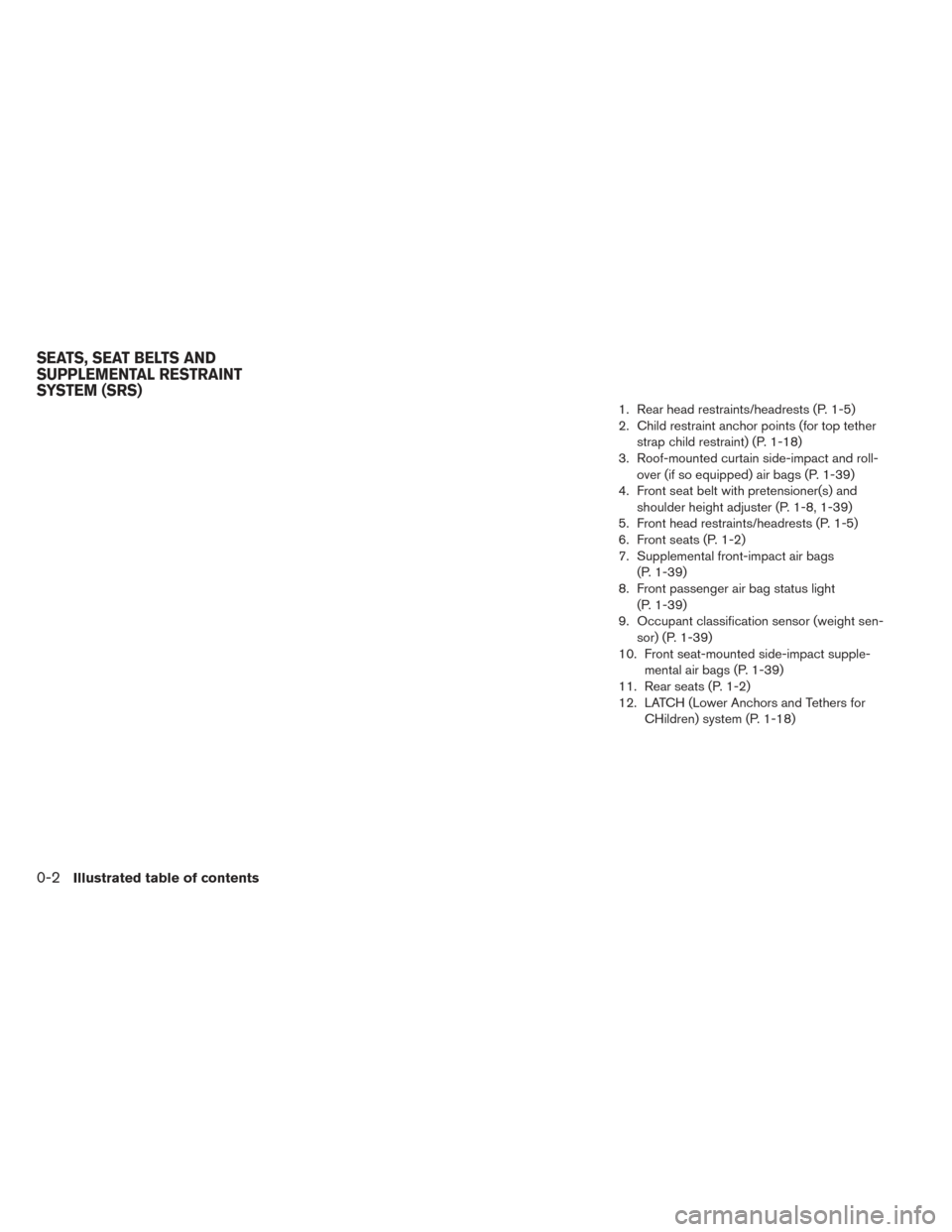
1. Rear head restraints/headrests (P. 1-5)
2. Child restraint anchor points (for top tetherstrap child restraint) (P. 1-18)
3. Roof-mounted curtain side-impact and roll- over (if so equipped) air bags (P. 1-39)
4. Front seat belt with pretensioner(s) and shoulder height adjuster (P. 1-8, 1-39)
5. Front head restraints/headrests (P. 1-5)
6. Front seats (P. 1-2)
7. Supplemental front-impact air bags (P. 1-39)
8. Front passenger air bag status light (P. 1-39)
9. Occupant classification sensor (weight sen- sor) (P. 1-39)
10. Front seat-mounted side-impact supple- mental air bags (P. 1-39)
11. Rear seats (P. 1-2)
12. LATCH (Lower Anchors and Tethers for CHildren) system (P. 1-18)
SEATS, SEAT BELTS AND
SUPPLEMENTAL RESTRAINT
SYSTEM (SRS)
0-2Illustrated table of contents
Page 100 of 424
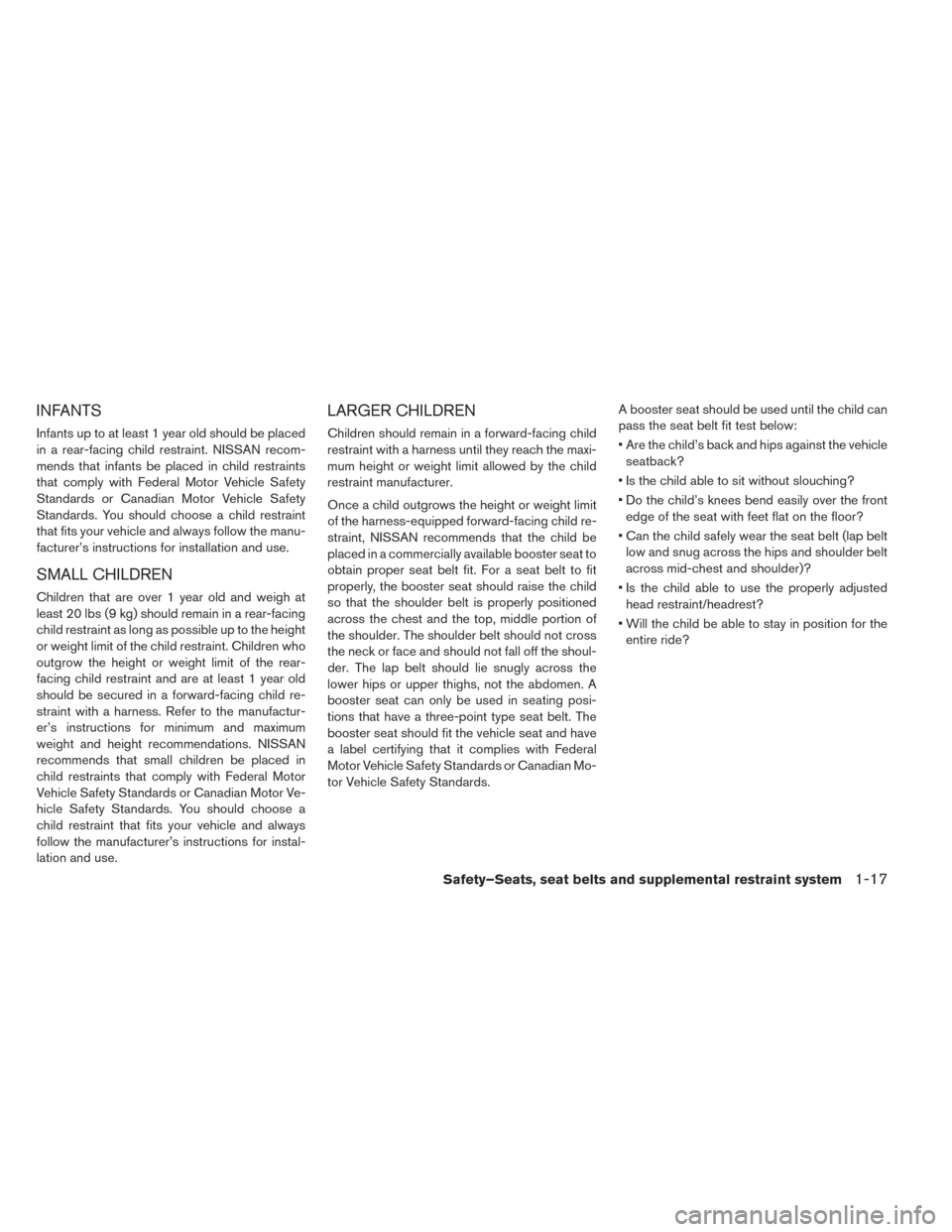
INFANTS
Infants up to at least 1 year old should be placed
in a rear-facing child restraint. NISSAN recom-
mends that infants be placed in child restraints
that comply with Federal Motor Vehicle Safety
Standards or Canadian Motor Vehicle Safety
Standards. You should choose a child restraint
that fits your vehicle and always follow the manu-
facturer’s instructions for installation and use.
SMALL CHILDREN
Children that are over 1 year old and weigh at
least 20 lbs (9 kg) should remain in a rear-facing
child restraint as long as possible up to the height
or weight limit of the child restraint. Children who
outgrow the height or weight limit of the rear-
facing child restraint and are at least 1 year old
should be secured in a forward-facing child re-
straint with a harness. Refer to the manufactur-
er’s instructions for minimum and maximum
weight and height recommendations. NISSAN
recommends that small children be placed in
child restraints that comply with Federal Motor
Vehicle Safety Standards or Canadian Motor Ve-
hicle Safety Standards. You should choose a
child restraint that fits your vehicle and always
follow the manufacturer’s instructions for instal-
lation and use.
LARGER CHILDREN
Children should remain in a forward-facing child
restraint with a harness until they reach the maxi-
mum height or weight limit allowed by the child
restraint manufacturer.
Once a child outgrows the height or weight limit
of the harness-equipped forward-facing child re-
straint, NISSAN recommends that the child be
placed in a commercially available booster seat to
obtain proper seat belt fit. For a seat belt to fit
properly, the booster seat should raise the child
so that the shoulder belt is properly positioned
across the chest and the top, middle portion of
the shoulder. The shoulder belt should not cross
the neck or face and should not fall off the shoul-
der. The lap belt should lie snugly across the
lower hips or upper thighs, not the abdomen. A
booster seat can only be used in seating posi-
tions that have a three-point type seat belt. The
booster seat should fit the vehicle seat and have
a label certifying that it complies with Federal
Motor Vehicle Safety Standards or Canadian Mo-
tor Vehicle Safety Standards.A booster seat should be used until the child can
pass the seat belt fit test below:
• Are the child’s back and hips against the vehicle
seatback?
• Is the child able to sit without slouching?
• Do the child’s knees bend easily over the front edge of the seat with feet flat on the floor?
• Can the child safely wear the seat belt (lap belt low and snug across the hips and shoulder belt
across mid-chest and shoulder)?
• Is the child able to use the properly adjusted head restraint/headrest?
• Will the child be able to stay in position for the entire ride?
Safety–Seats, seat belts and supplemental restraint system1-17
Page 103 of 424
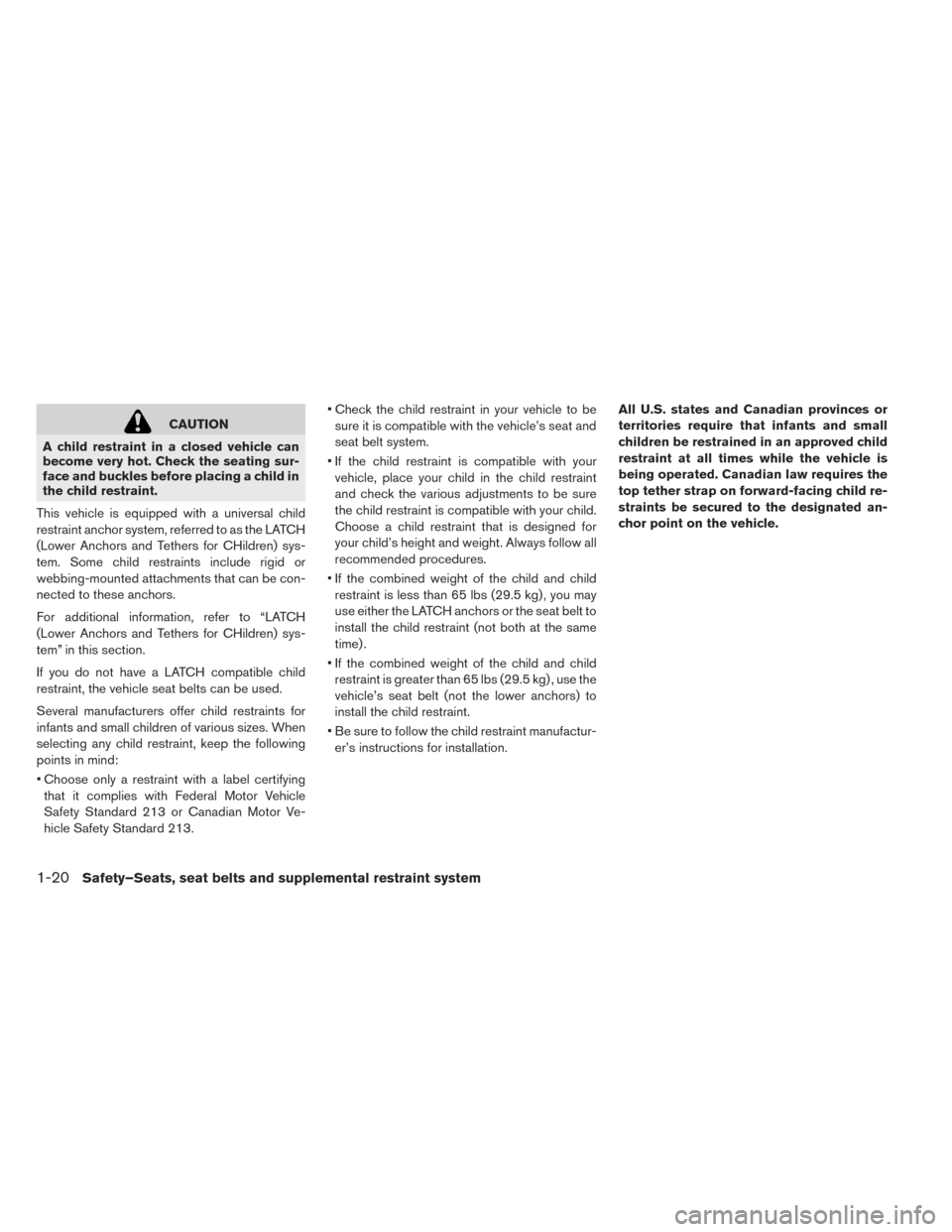
CAUTION
A child restraint in a closed vehicle can
become very hot. Check the seating sur-
face and buckles before placing a child in
the child restraint.
This vehicle is equipped with a universal child
restraint anchor system, referred to as the LATCH
(Lower Anchors and Tethers for CHildren) sys-
tem. Some child restraints include rigid or
webbing-mounted attachments that can be con-
nected to these anchors.
For additional information, refer to “LATCH
(Lower Anchors and Tethers for CHildren) sys-
tem” in this section.
If you do not have a LATCH compatible child
restraint, the vehicle seat belts can be used.
Several manufacturers offer child restraints for
infants and small children of various sizes. When
selecting any child restraint, keep the following
points in mind:
• Choose only a restraint with a label certifying that it complies with Federal Motor Vehicle
Safety Standard 213 or Canadian Motor Ve-
hicle Safety Standard 213. • Check the child restraint in your vehicle to be
sure it is compatible with the vehicle’s seat and
seat belt system.
• If the child restraint is compatible with your vehicle, place your child in the child restraint
and check the various adjustments to be sure
the child restraint is compatible with your child.
Choose a child restraint that is designed for
your child’s height and weight. Always follow all
recommended procedures.
• If the combined weight of the child and child restraint is less than 65 lbs (29.5 kg) , you may
use either the LATCH anchors or the seat belt to
install the child restraint (not both at the same
time) .
• If the combined weight of the child and child restraint is greater than 65 lbs (29.5 kg) , use the
vehicle’s seat belt (not the lower anchors) to
install the child restraint.
• Be sure to follow the child restraint manufactur- er’s instructions for installation. All U.S. states and Canadian provinces or
territories require that infants and small
children be restrained in an approved child
restraint at all times while the vehicle is
being operated. Canadian law requires the
top tether strap on forward-facing child re-
straints be secured to the designated an-
chor point on the vehicle.
1-20Safety–Seats, seat belts and supplemental restraint system
Page 104 of 424
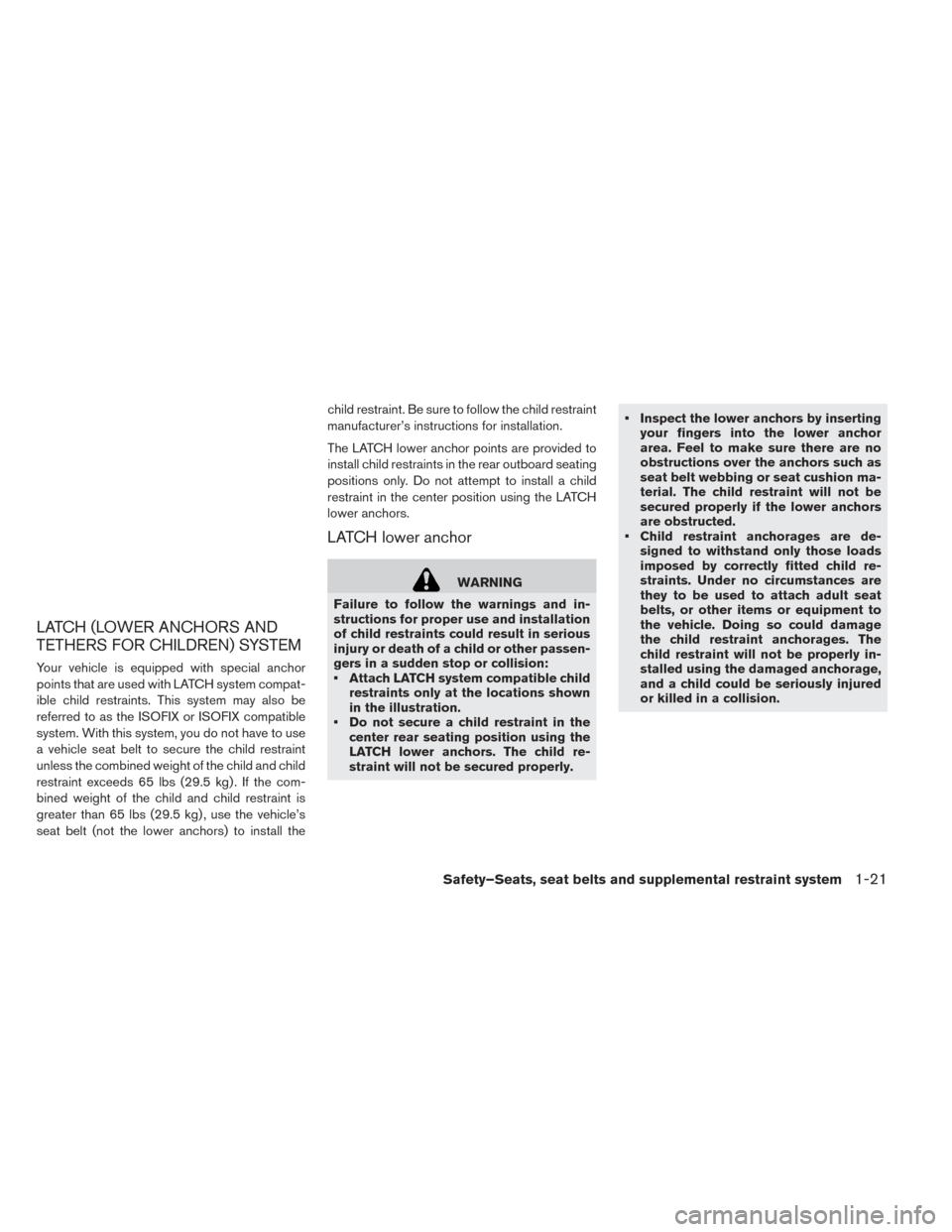
LATCH (LOWER ANCHORS AND
TETHERS FOR CHILDREN) SYSTEM
Your vehicle is equipped with special anchor
points that are used with LATCH system compat-
ible child restraints. This system may also be
referred to as the ISOFIX or ISOFIX compatible
system. With this system, you do not have to use
a vehicle seat belt to secure the child restraint
unless the combined weight of the child and child
restraint exceeds 65 lbs (29.5 kg) . If the com-
bined weight of the child and child restraint is
greater than 65 lbs (29.5 kg) , use the vehicle’s
seat belt (not the lower anchors) to install thechild restraint. Be sure to follow the child restraint
manufacturer’s instructions for installation.
The LATCH lower anchor points are provided to
install child restraints in the rear outboard seating
positions only. Do not attempt to install a child
restraint in the center position using the LATCH
lower anchors.
LATCH lower anchor
WARNING
Failure to follow the warnings and in-
structions for proper use and installation
of child restraints could result in serious
injury or death of a child or other passen-
gers in a sudden stop or collision:
• Attach LATCH system compatible child restraints only at the locations shown
in the illustration.
• Do not secure a child restraint in the center rear seating position using the
LATCH lower anchors. The child re-
straint will not be secured properly. • Inspect the lower anchors by inserting
your fingers into the lower anchor
area. Feel to make sure there are no
obstructions over the anchors such as
seat belt webbing or seat cushion ma-
terial. The child restraint will not be
secured properly if the lower anchors
are obstructed.
• Child restraint anchorages are de- signed to withstand only those loads
imposed by correctly fitted child re-
straints. Under no circumstances are
they to be used to attach adult seat
belts, or other items or equipment to
the vehicle. Doing so could damage
the child restraint anchorages. The
child restraint will not be properly in-
stalled using the damaged anchorage,
and a child could be seriously injured
or killed in a collision.
Safety–Seats, seat belts and supplemental restraint system1-21
Page 107 of 424
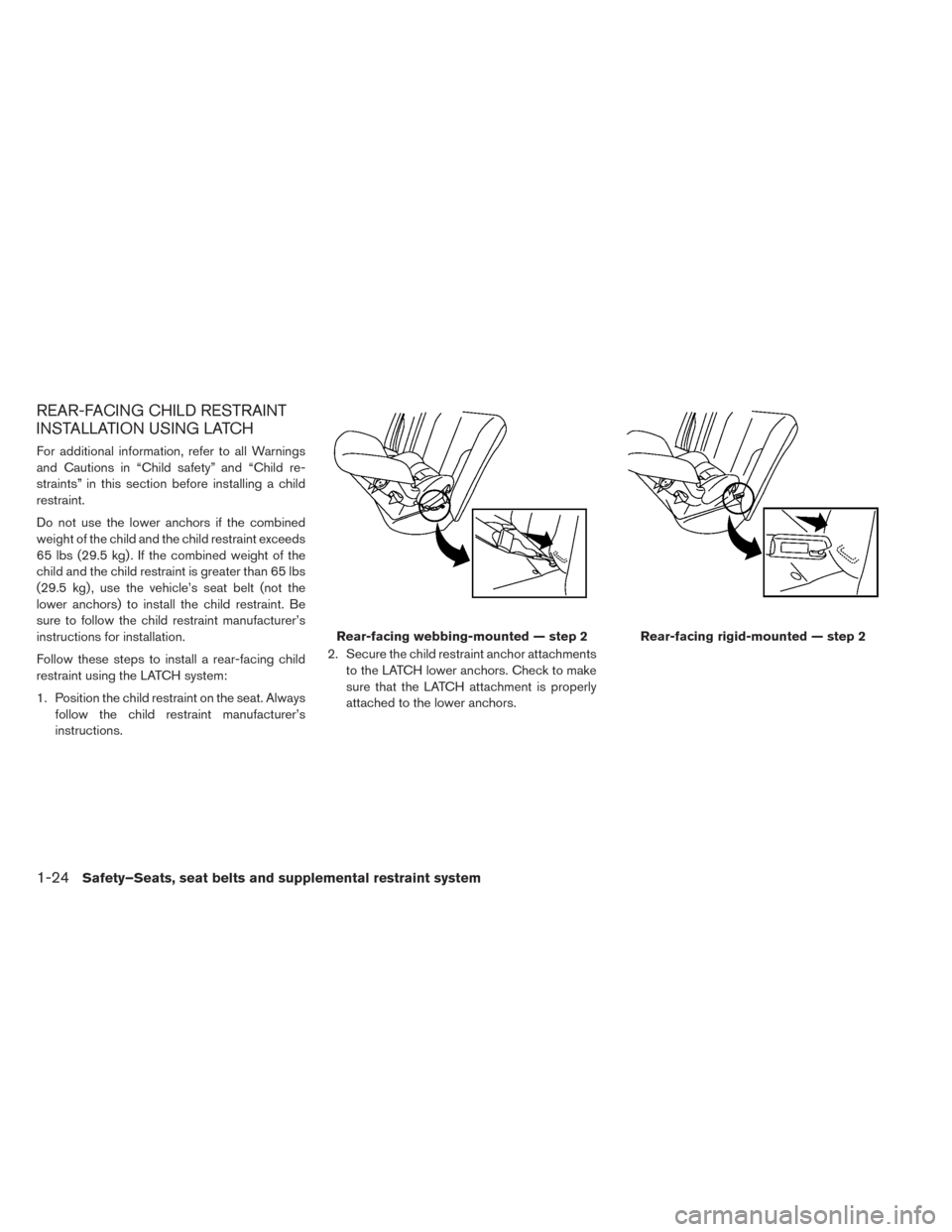
REAR-FACING CHILD RESTRAINT
INSTALLATION USING LATCH
For additional information, refer to all Warnings
and Cautions in “Child safety” and “Child re-
straints” in this section before installing a child
restraint.
Do not use the lower anchors if the combined
weight of the child and the child restraint exceeds
65 lbs (29.5 kg) . If the combined weight of the
child and the child restraint is greater than 65 lbs
(29.5 kg) , use the vehicle’s seat belt (not the
lower anchors) to install the child restraint. Be
sure to follow the child restraint manufacturer’s
instructions for installation.
Follow these steps to install a rear-facing child
restraint using the LATCH system:
1. Position the child restraint on the seat. Alwaysfollow the child restraint manufacturer’s
instructions. 2. Secure the child restraint anchor attachments
to the LATCH lower anchors. Check to make
sure that the LATCH attachment is properly
attached to the lower anchors.
Rear-facing webbing-mounted — step 2Rear-facing rigid-mounted — step 2
1-24Safety–Seats, seat belts and supplemental restraint system
Page 109 of 424
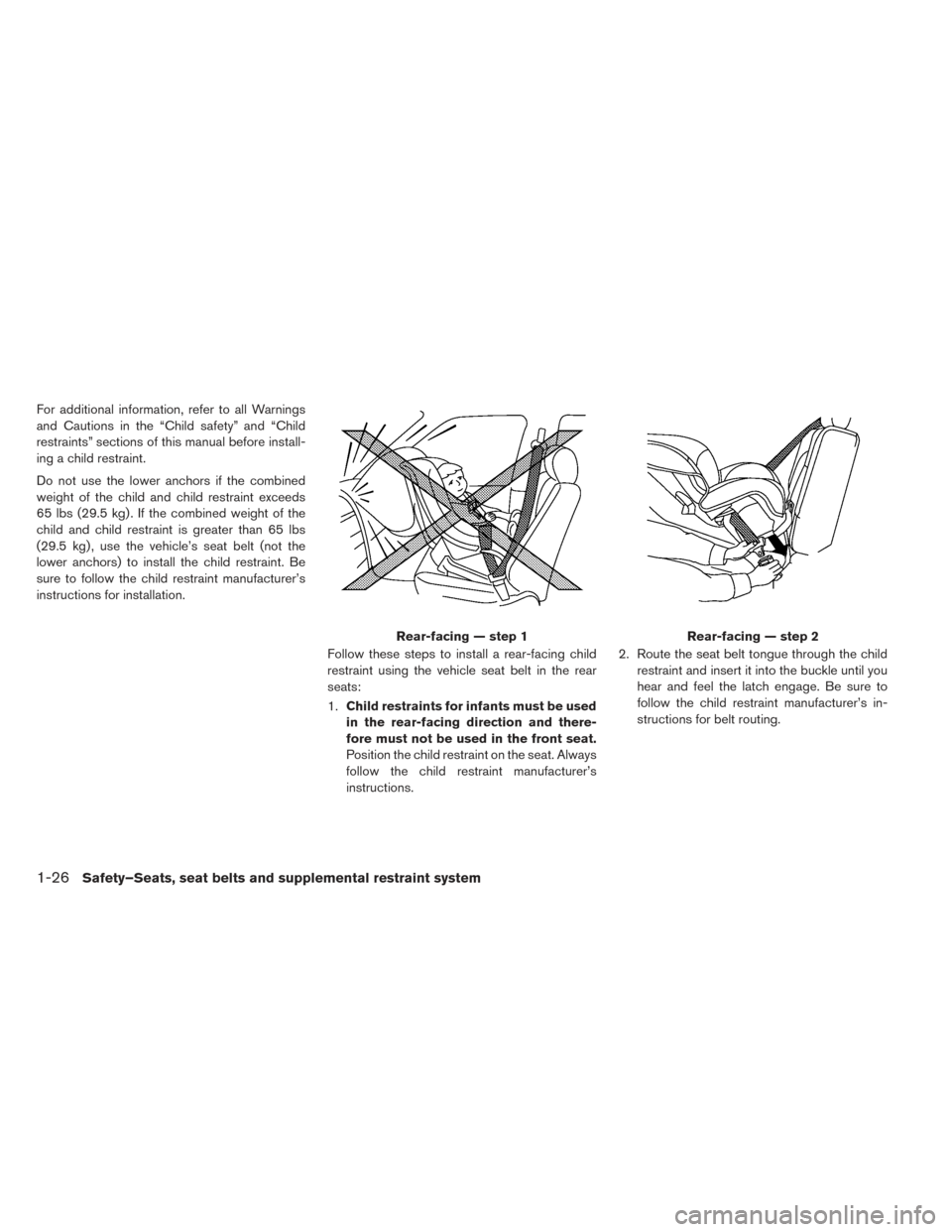
For additional information, refer to all Warnings
and Cautions in the “Child safety” and “Child
restraints” sections of this manual before install-
ing a child restraint.
Do not use the lower anchors if the combined
weight of the child and child restraint exceeds
65 lbs (29.5 kg) . If the combined weight of the
child and child restraint is greater than 65 lbs
(29.5 kg) , use the vehicle’s seat belt (not the
lower anchors) to install the child restraint. Be
sure to follow the child restraint manufacturer’s
instructions for installation.Follow these steps to install a rear-facing child
restraint using the vehicle seat belt in the rear
seats:
1.Child restraints for infants must be used
in the rear-facing direction and there-
fore must not be used in the front seat.
Position the child restraint on the seat. Always
follow the child restraint manufacturer’s
instructions. 2. Route the seat belt tongue through the child
restraint and insert it into the buckle until you
hear and feel the latch engage. Be sure to
follow the child restraint manufacturer’s in-
structions for belt routing.
Rear-facing — step 1Rear-facing — step 2
1-26Safety–Seats, seat belts and supplemental restraint system
Page 111 of 424
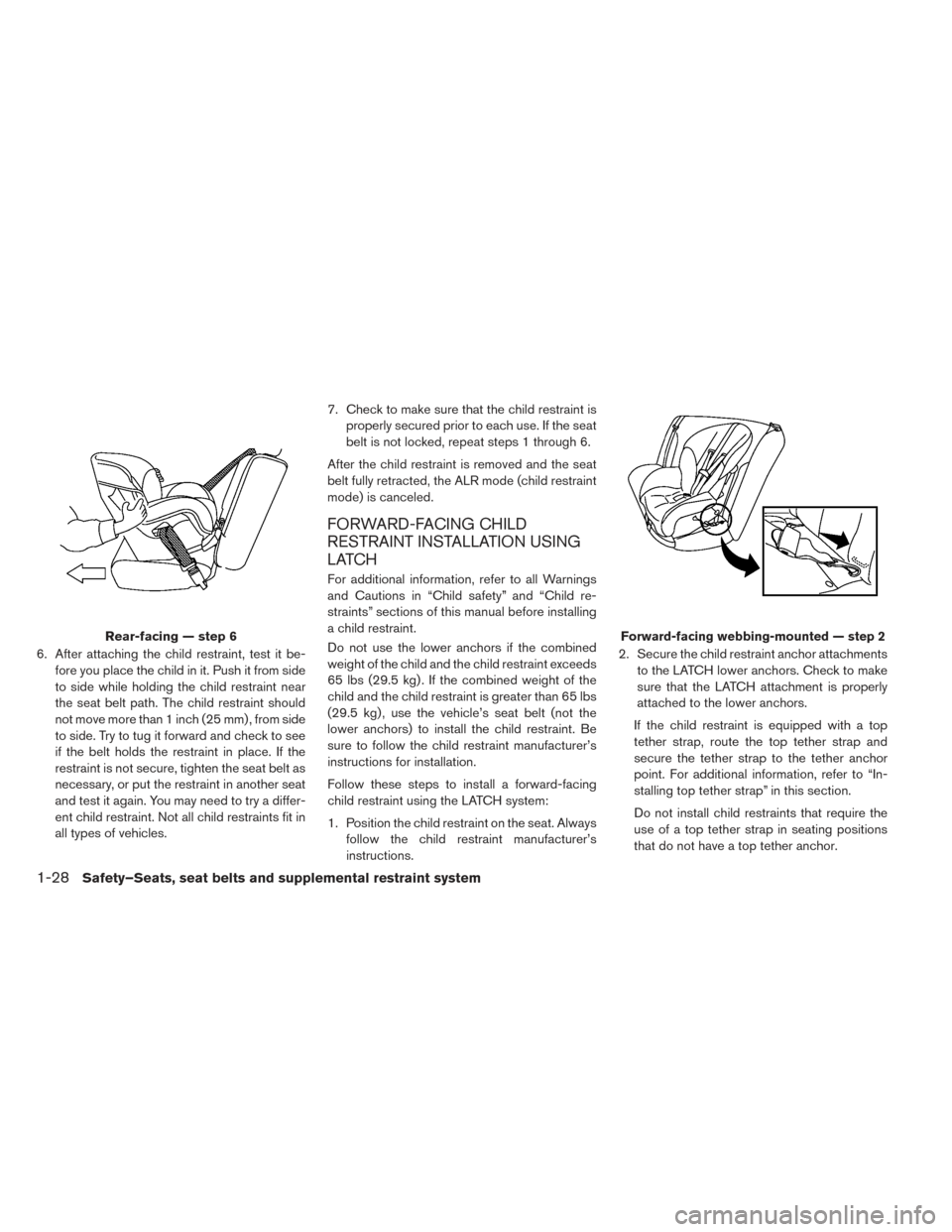
6. After attaching the child restraint, test it be-fore you place the child in it. Push it from side
to side while holding the child restraint near
the seat belt path. The child restraint should
not move more than 1 inch (25 mm) , from side
to side. Try to tug it forward and check to see
if the belt holds the restraint in place. If the
restraint is not secure, tighten the seat belt as
necessary, or put the restraint in another seat
and test it again. You may need to try a differ-
ent child restraint. Not all child restraints fit in
all types of vehicles. 7. Check to make sure that the child restraint is
properly secured prior to each use. If the seat
belt is not locked, repeat steps 1 through 6.
After the child restraint is removed and the seat
belt fully retracted, the ALR mode (child restraint
mode) is canceled.
FORWARD-FACING CHILD
RESTRAINT INSTALLATION USING
LATCH
For additional information, refer to all Warnings
and Cautions in “Child safety” and “Child re-
straints” sections of this manual before installing
a child restraint.
Do not use the lower anchors if the combined
weight of the child and the child restraint exceeds
65 lbs (29.5 kg) . If the combined weight of the
child and the child restraint is greater than 65 lbs
(29.5 kg) , use the vehicle’s seat belt (not the
lower anchors) to install the child restraint. Be
sure to follow the child restraint manufacturer’s
instructions for installation.
Follow these steps to install a forward-facing
child restraint using the LATCH system:
1. Position the child restraint on the seat. Always follow the child restraint manufacturer’s
instructions. 2. Secure the child restraint anchor attachments
to the LATCH lower anchors. Check to make
sure that the LATCH attachment is properly
attached to the lower anchors.
If the child restraint is equipped with a top
tether strap, route the top tether strap and
secure the tether strap to the tether anchor
point. For additional information, refer to “In-
stalling top tether strap” in this section.
Do not install child restraints that require the
use of a top tether strap in seating positions
that do not have a top tether anchor.
Rear-facing — step 6Forward-facing webbing-mounted — step 2
1-28Safety–Seats, seat belts and supplemental restraint system
Page 115 of 424
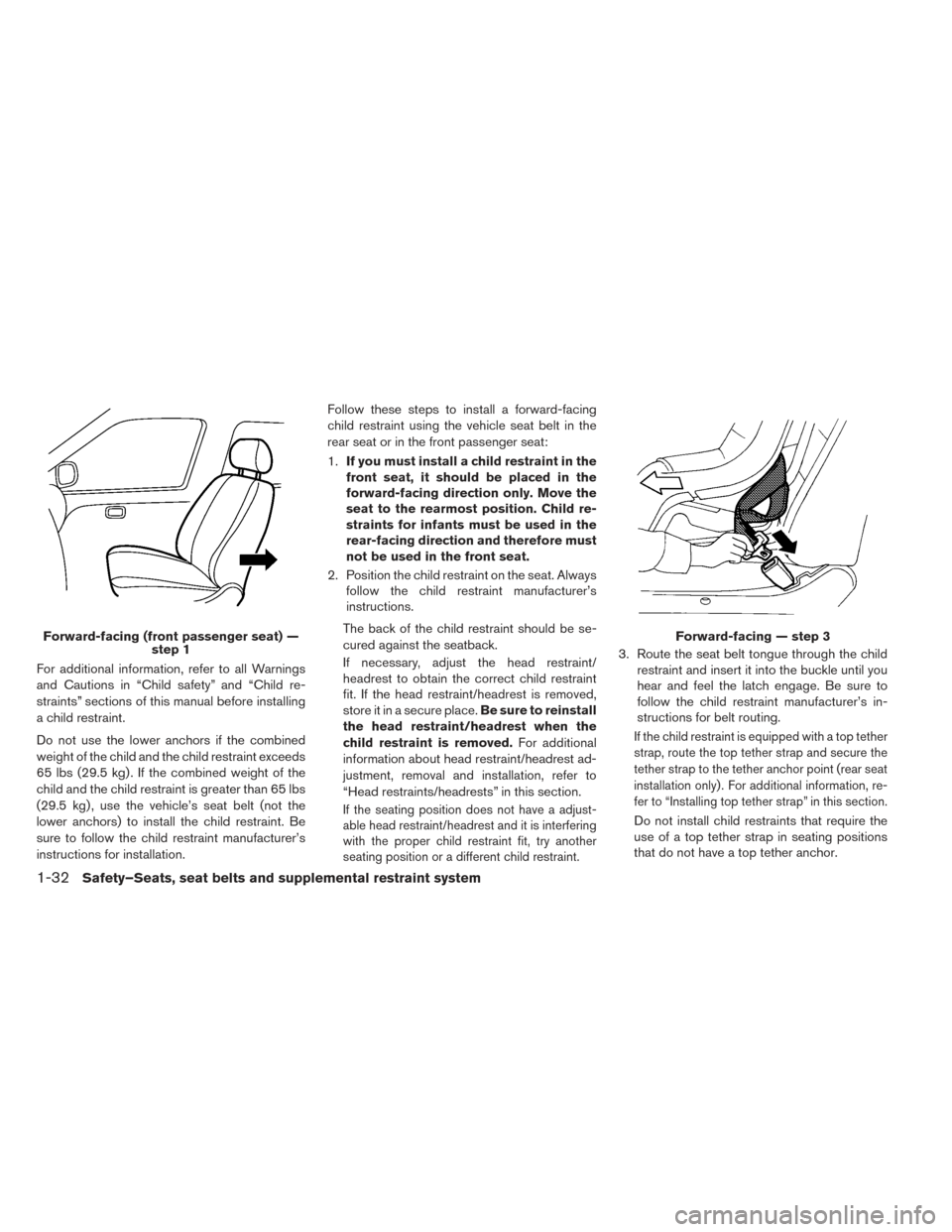
For additional information, refer to all Warnings
and Cautions in “Child safety” and “Child re-
straints” sections of this manual before installing
a child restraint.
Do not use the lower anchors if the combined
weight of the child and the child restraint exceeds
65 lbs (29.5 kg) . If the combined weight of the
child and the child restraint is greater than 65 lbs
(29.5 kg) , use the vehicle’s seat belt (not the
lower anchors) to install the child restraint. Be
sure to follow the child restraint manufacturer’s
instructions for installation.Follow these steps to install a forward-facing
child restraint using the vehicle seat belt in the
rear seat or in the front passenger seat:
1.
If you must install a child restraint in the
front seat, it should be placed in the
forward-facing direction only. Move the
seat to the rearmost position. Child re-
straints for infants must be used in the
rear-facing direction and therefore must
not be used in the front seat.
2. Position the child restraint on the seat. Always follow the child restraint manufacturer’s
instructions.
The back of the child restraint should be se-
cured against the seatback.
If necessary, adjust the head restraint/
headrest to obtain the correct child restraint
fit. If the head restraint/headrest is removed,
store it in a secure place. Be sure to reinstall
the head restraint/headrest when the
child restraint is removed. For additional
information about head restraint/headrest ad-
justment, removal and installation, refer to
“Head restraints/headrests” in this section.
If the seating position does not have a adjust-
able head restraint/headrest and it is interfering
with the proper child restraint fit, try another
seating position or a different child restraint.
3. Route the seat belt tongue through the child restraint and insert it into the buckle until you
hear and feel the latch engage. Be sure to
follow the child restraint manufacturer’s in-
structions for belt routing.
If the child restraint is equipped with a top tether
strap, route the top tether strap and secure the
tether strap to the tether anchor point (rear seat
installation only) . For additional information, re-
fer to “Installing top tether strap” in this section.
Do not install child restraints that require the
use of a top tether strap in seating positions
that do not have a top tether anchor.
Forward-facing (front passenger seat) — step 1Forward-facing — step 3
1-32Safety–Seats, seat belts and supplemental restraint system